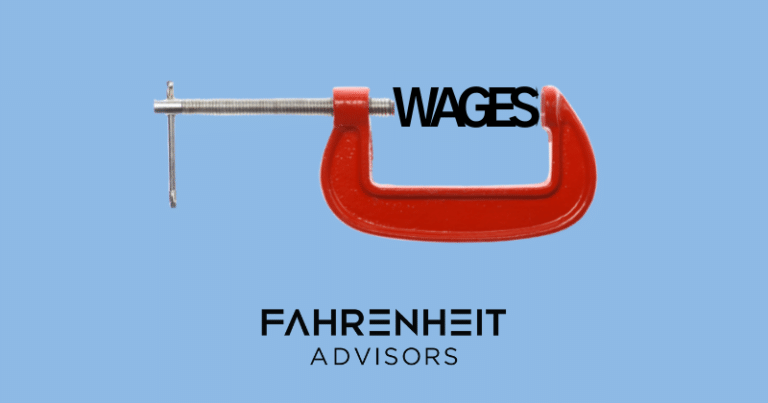5 Steps To Control Wage Compression While Managing Minimum Wage Increases

While many workers have petitioned for an increase in the federal minimum wage, the federal rate has held steady at $7.25 since 2009. The federal government has otherwise deferred to states on any additional increases or adjustments. Some states were early movers in a minimum wage increase – such as California. Others were, much to the chagrin of minimum wage earners, slower to rise above the federally mandated minimum wage. For example, Virginia lawmakers attempted unsuccessfully to increase the state minimum wage to $11.00 in 2017. However, on May 1, 2021, Virginia passed a law that increased its minimum wage to $9.50 — a 31 percent increase over the $7.25, which has tracked with the federal rate since 2009. If you are a Virginia business owner, you’re already adjusting to fit this new labor cost into your current business model. And there’s more to come. Subsequent minimum wage increases scheduled for at least the next two years will require you to take an even deeper dive into managing your labor costs and other expenses in the long term.
For business owners, one of the biggest concerns with minimum wage increases is wage compression — also called salary compression — which occurs when the pay gap between a supervisor and their direct report becomes smaller. It’s critical that you know how to take control of wage compression while managing minimum wage increases.
Robust analyses and careful planning can help you manage the annual minimum wage increases in the coming years, but wage compression may prove to be a heavy burden — particularly for small business owners. While managing the state-mandated minimum increase, business owners will also need to determine how to address the wages of their employees currently making more than minimum wage.
To get you up to speed, let’s take a closer look at the risks of wage compression to your business. Then I’ll share 5 steps to take control of wage compression so you can best manage its impacts on your business, in both the short and long term.
The 3 Risks of Wage Compression
To successfully respond to and prepare for wage compression risks, you need to look at wage compression through both a finance and human resource lens. Wage compression brings human capital considerations, and each of those comes with a cost.
1. Loss of employee motivation and productivity
Compensation may be one of the largest expenses in your business, and it is also the biggest motivator for your employees. Supervisors expect to make more than their direct reports. If a supervisor is aware that a direct report is making nearly the same salary, there will be a direct negative impact on that supervisor’s motivation.
One consequence of motivation loss is typically a drop in productivity. Clearly any productivity loss is costly for your business. Compounding the issue is another consequence of motivation loss: employee retention challenges. When your employees lose their motivation to work in your business, they’ll look elsewhere.
2. Difficulty recruiting new employees
If you plan to stand firm against increasing the salaries in your supervisory roles, remember that many competitors are already offering $12-$15 as their starting pay. Finding qualified candidates in today’s current market will require offering some incentives to give your company the competitive advantage in recruiting new talent and retaining your current supervisors.
3. Increased turnover costs
Employee satisfaction is a major component of a positive workplace culture. It is also a tool you can use to make sure your employees don’t jump ship for a competitor. Salary definitely plays a role. If your employees do leave, the current job market favors candidates, making it challenging to hire and retain qualified talent. According to the April 2021 Jobs Report from the National Federation of Independent Business, 92 percent of small business owners reported few or no qualified applicants for their available positions.
The cost of losing your employees could be exponentially worse than the cost of increasing salaries across the board. It’s estimated the cost of replacing an entry-level employee is 30 to 40 percent of their annual salary, and for a highly skilled employee it can be up to 400 percent. It’s also important for you to note the inherent opportunity cost and morale decline associated with employee departures.
These risks — productivity, recruitment, and turnover — are already mission-critical issues for your business that could potentially be turned on their head thanks to wage compression. So let’s focus on how you can take control.
5 Steps To Take Control of Wage Compression
Here’s the good news: Like so many other risks to your business, wage compression is a risk that can be successfully managed. All it takes is planning, focus, and intent.
Here’s how you can take control of wage compression while managing minimum wage increases:
1. Make data-driven decisions
Sticking to the data will help you draw a line between the emotional and the financial implications of wage compression. The Society for Human Resource Management suggests the salaries of direct reports should be no more than 95 percent of supervisors’ salaries. This could be the threshold where you decide to take action. Determining what type of action to take will depend on a deeper analysis of your labor costs and the impact of wage increases to your margins. It’s not going to be a one-size-fits-all solution.
2. Audit your compensation plan
Are your compensation plans based on length of time with the company, merit, experience? Pay increases should hold fast to the criteria you have already established in your business’ compensation plan. Be consistent in how you apply pay increases, and be transparent with your employees so they clearly understand what to expect.
3. Assess your supervisory levels
How many supervisory levels do you have? Now could be a good time to restructure your management positions. If you have a supervisor, manager, and senior manager, you may need to decide whether it’s necessary to house those respective duties in three different positions. Take it a step further: Do your job descriptions signal the right pay range? If not, consider adjusting your job descriptions to better suit the type of work that is expected of employees who are higher on the pay scale.
4. Be proactive
It’s critical that you take action before your employees demand it. Once you’ve scoured your books to know when, how, and if you can increase wages, you may decide that a small, across-the-board increase makes sense. Ask your employees about how they value other compensation measures you might offer, such as childcare, rideshare fare, or skills training. Factor in whether the cost and feasibility of offering additional benefits is favorable to the cost of a more significant pay increase. Be sure to model these scenarios in your expense projections for at least the next five years so you’re prepared for ongoing wage compression that will result from the annual minimum wage increases.
5. Communicate, communicate, communicate
Talk to your employees. Tell them what’s going on and what you’re aiming to do. Let them know you’ve looked at all the wages and you are trying to do what’s fair. Explain that you also need to keep the ship afloat. You don’t need to have all the answers in the beginning, but having open lines of communication with your employees will go a long way in continuing to build trust with them. And trust is absolutely essential to today’s successful workplaces.
Responding to minimum wage increases and wage compression is both a sprint and a marathon. Not only do you need to respond now to the most immediate change and adjust your business to manage the impacts, you also need to be prepared to manage future wage increases and ongoing wage compression.
Virginia’s minimum wage will increase again January 1, 2022, to $11, with another increase to $12 on January 1, 2023. Additional increases are on the table and will be considered by the Virginia General Assembly by July 1, 2024. There is also a push to raise the federal minimum wage from $7.25 to $15.
About the Author
 Megan Price provides a broad range of experience in strategy development, project management, organizational behavior, corporate culture, stakeholder relations, process integration, and change management. She encourages a collaborative process and tailors work to her individual client.
Megan Price provides a broad range of experience in strategy development, project management, organizational behavior, corporate culture, stakeholder relations, process integration, and change management. She encourages a collaborative process and tailors work to her individual client.
Megan serves her clients by drawing on her multi-dimensional industry experience, which includes agriculture, legal services, state and federal government, infrastructure development, and electric utilities. She was a co-founder of an education support business where she worked closely with private companies, state and local government, and non-profit organizations to establish partnerships and acquire funding. She has provided strategic planning, operations management, marketing support, and vendor relations for small businesses and start-ups.